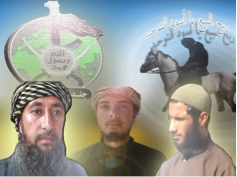
The image was produced by Jund Ansar Allah, a local terrorist network in the Gaza Strip affiliated with the global jihad movement, which was behind the failed attempt to perpetrate a showcase terrorist attack at the Nahal Oz fuel terminal (8 June 2009). The group refers to this incident as ghazwat al-balagh (raid of proclamation) and includes images of three JAA members killed in the raid: Hani Muhammad al-Tarabin or “Abu `Adnan,” Tahir `Isa `Isa or “Abu Muslim” and Fahad Muhammad al-Minawi or “Aby Suhayb.”
The group’s logo incorporates many common elements of the jihadist visual lexicon: two crossed swords, the seal of the prophet, an AK-47 and a black banner. In the background Europe, Asia and Africa appear without national divisions (reflecting jihadist distaste for national causes or borders imposed on the Muslim world during colonialism).
The caption is a play on and an indirect allusion to Qur’anic verse 2:16. The verse expresses the Qur’anic concept of “striking out on a good deal when exchanging the right path for the wrong path.” There is an even stronger direct allusion to verse 9:111, where it is said: “be happy with your [good!] deal you made.” The concept is a prevalent one in Islam, and spiritual choices are often put in economic terms (i.e., “getting a good deal when following God’s commands”).
 Skip to content
Skip to content
